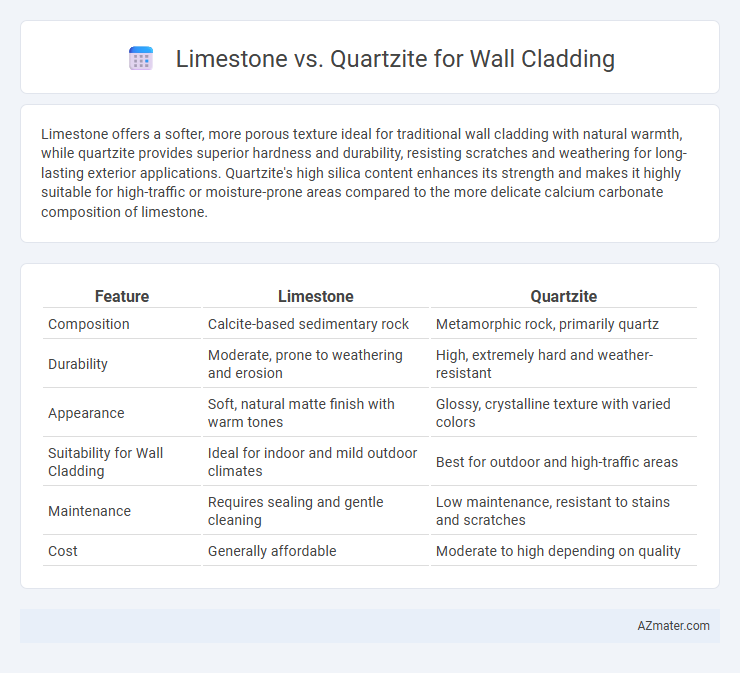Limestone offers a softer, more porous texture ideal for traditional wall cladding with natural warmth, while quartzite provides superior hardness and durability, resisting scratches and weathering for long-lasting exterior applications. Quartzite's high silica content enhances its strength and makes it highly suitable for high-traffic or moisture-prone areas compared to the more delicate calcium carbonate composition of limestone.
Table of Comparison
| Feature | Limestone | Quartzite |
|---|---|---|
| Composition | Calcite-based sedimentary rock | Metamorphic rock, primarily quartz |
| Durability | Moderate, prone to weathering and erosion | High, extremely hard and weather-resistant |
| Appearance | Soft, natural matte finish with warm tones | Glossy, crystalline texture with varied colors |
| Suitability for Wall Cladding | Ideal for indoor and mild outdoor climates | Best for outdoor and high-traffic areas |
| Maintenance | Requires sealing and gentle cleaning | Low maintenance, resistant to stains and scratches |
| Cost | Generally affordable | Moderate to high depending on quality |
Introduction to Wall Cladding Materials
Limestone and quartzite are popular wall cladding materials known for their durability and aesthetic appeal. Limestone offers a classic, soft texture with natural earthy tones, making it ideal for traditional and rustic designs, while quartzite provides a harder, more resistant surface with a glossy finish suitable for modern and high-traffic areas. Both materials vary in porosity and maintenance requirements, influencing their performance in different environmental conditions.
What is Limestone?
Limestone is a sedimentary rock composed mainly of calcium carbonate, formed from the skeletal fragments of marine organisms such as coral and mollusks. Its natural porous texture and neutral color palette make it a popular choice for wall cladding in both interior and exterior applications. Limestone offers moderate durability and a distinct matte finish, distinguishing it from the harder, more crystalline quartzite.
What is Quartzite?
Quartzite is a durable, non-foliated metamorphic rock formed from sandstone under intense heat and pressure, known for its hardness and resistance to weathering. Its natural composition primarily includes quartz grains fused together, making it ideal for wall cladding in both exterior and interior applications due to its high durability and attractive crystalline appearance. Quartzite's dense structure and low porosity offer superior stain resistance compared to limestone, ensuring long-lasting aesthetic appeal and structural integrity in architectural designs.
Aesthetic Differences: Limestone vs Quartzite
Limestone wall cladding offers a soft, earthy appearance with subtle grain patterns and natural warm tones, creating a timeless and elegant aesthetic. Quartzite features a more vibrant and polished look, characterized by its crystalline structure and a range of colors from white to gray and even blue hues, lending a modern and luxurious feel. The choice between limestone and quartzite for wall cladding largely depends on the desired visual impact, with limestone providing a classic, rustic charm and quartzite delivering a sleek, contemporary finish.
Durability and Strength Comparison
Quartzite exhibits superior durability and strength compared to limestone, making it an ideal choice for wall cladding in high-traffic or exposed areas. Limestone, being a softer sedimentary rock, is more prone to scratching, weathering, and erosion, which limits its longevity on exterior walls. The tightly interlocked quartz grains in quartzite create a hard, dense surface that resists impact and abrasion, ensuring long-lasting wall cladding performance.
Maintenance Requirements for Each Stone
Limestone wall cladding requires regular sealing and gentle cleaning to prevent staining and erosion due to its porous nature. Quartzite demands minimal maintenance, as its dense, hard surface resists scratching, weathering, and staining more effectively. Routine inspections and occasional cleaning suffice to preserve quartzite's durability and aesthetic appeal over time.
Weather Resistance and Longevity
Quartzite offers superior weather resistance and longevity compared to limestone due to its natural hardness and low porosity, making it highly resistant to moisture, freeze-thaw cycles, and erosion. Limestone, being a softer and more porous sedimentary rock, is more susceptible to weathering, acid rain, and surface degradation over time, requiring regular maintenance and sealing for outdoor wall cladding. For durable exterior applications, quartzite's dense crystalline structure ensures greater durability and a longer lifespan, preserving aesthetic appeal in harsh weather conditions.
Cost Considerations: Limestone vs Quartzite
Limestone generally offers a more budget-friendly option for wall cladding, with pricing that is typically lower due to its abundant availability and easier quarrying process. Quartzite, known for its superior hardness and durability, commands a higher price reflecting its labor-intensive extraction and processing requirements. When budgeting for wall cladding, the cost difference between limestone and quartzite can be significant, with quartzite often costing 30-50% more depending on quality and source.
Sustainability and Environmental Impact
Limestone and quartzite differ significantly in sustainability and environmental impact when used for wall cladding. Limestone is sedimentary, often quarried with lower energy consumption but can release carbon during processing, while quartzite, a metamorphic rock, requires higher energy for extraction and processing but offers superior durability and longevity, reducing the need for frequent replacements. Choosing quartzite promotes long-term sustainability due to its resilience and minimal maintenance, whereas limestone's environmental cost is lower upfront but may result in higher lifetime emissions.
Choosing the Right Stone for Your Project
Limestone offers a classic, soft texture with a warm, earthy palette ideal for traditional wall cladding, while quartzite provides exceptional durability and a sleek, crystalline appearance suited for modern designs. Selecting the right stone depends on factors such as environmental exposure, maintenance requirements, and aesthetic goals, with quartzite excelling in high-traffic or weather-exposed areas due to its hardness and resistance to erosion. Understanding the physical properties, cost considerations, and long-term performance of limestone versus quartzite ensures optimal results for both residential and commercial wall cladding projects.

Infographic: Limestone vs Quartzite for Wall Cladding
 azmater.com
azmater.com